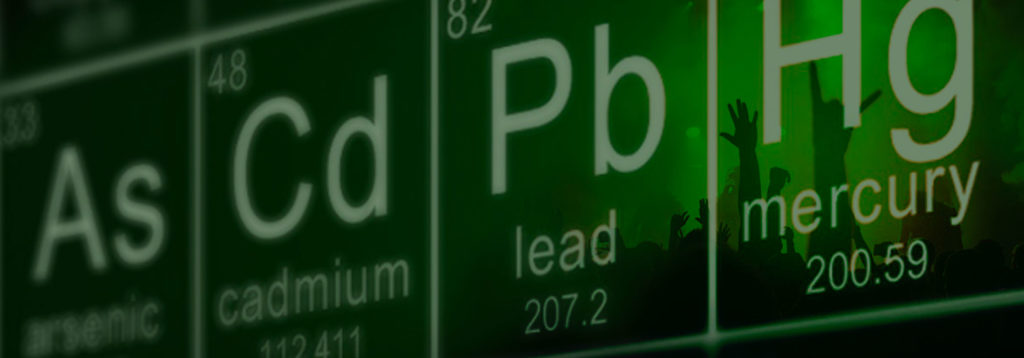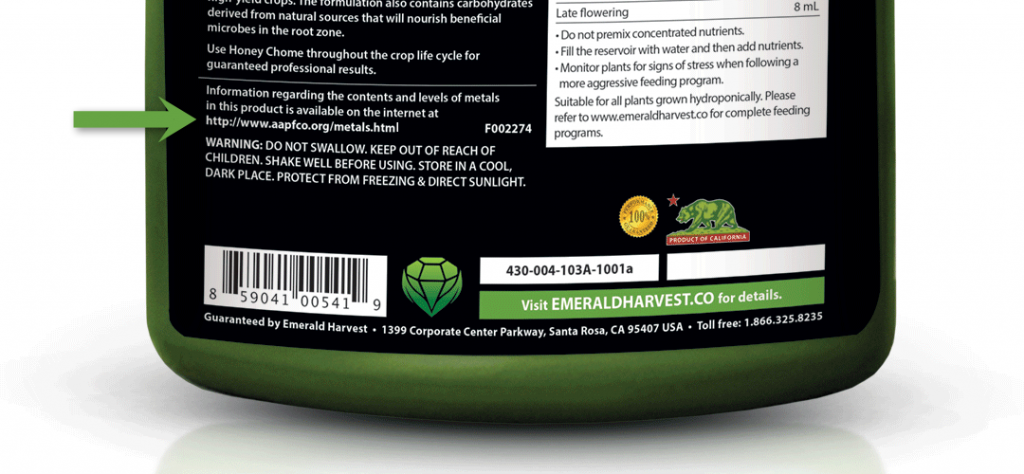
In agriculture as in music, heavy metal has a bad-boy reputation. And for good reason. Lead poisoning has made headlines as a public health concern for generations, and heightened regulation and consumer demand have slowly but surely eradicated lead from the surfaces and appliances we interact with. Mercury poisoning, too, has entered the public consciousness, motivating consumers to dramatically reduce their canned tuna intake.1 Exposure to many other heavy metals still put people at risk of potentially devastating health consequences. So why are these metals still common in fertilizers?
Heavy metals—chemical elements with high density compared to water—can be found in manures and inorganic fertilizers and are concentrated in soils according to its geological characteristics.2 Many of these metals are essential or beneficial to plant growth: namely, cobalt (Co), copper (Cu), iron (Fe), manganese (Mn), molybdenum (Mo), nickel (Ni) and zinc (Zn). In excess, however, these elements have undesirable consequences on both plant and human life; the Environmental Protection Agency has classified them as human carcinogens. Of particular concern are cadmium, chromium, mercury, lead and arsenic, which have deleterious effects on multiple organs of the body, even at very low levels.3 The degree to which these metals are harmful to humans depends on the dose, route of exposure and exposure time.4
Heavy metal toxicity in cannabis is notoriously difficult to spot due to its high “tolerance” for these undesirable elements.5 In fact, it is such a strong accumulator of heavy metals that hemp has been used for bioremediation, the process of taking pollutants up from the soil through the roots and into plant tissues.6 What’s more, well-meaning and well-researched growers may be the most likely to put their customers at risk: Growing for higher concentrations of THC leads to higher concentrations of heavy metals and pesticide residue.7
Because cannabis is not yet legal on the federal level in the US, cannabis fertilizer products aren’t subject to nationwide regulation by the Food and Drug Administration. This lack of oversight has created a wild west for commercial and amateur growers alike, who are responsible only to the regulatory authorities in their respective states. It has also allowed fertilizer brands to introduce higher levels of heavy metals into our water and soils, where they have the potential to accumulate and leech into the agricultural system and food supply.
According to the Association of American Plant Food Control Officials (AAPFCO), heavy metals in plant fertilizers “generally do not pose harm to human health or the environment.”8 The organization offers a guide to heavy-metal upper limits in fertilizers containing guaranteed amounts of phosphates and/or micronutrients according to the following table.
| Metals | ppm per 1% P2O5 | ppm per 1% Micronutrient(3) |
|---|---|---|
| Arsenic | 13 | 112 |
| Cadmium | 10 | 82 |
| Cobalt | 136(6) | 2,228(6) |
| Lead | 61 | 463 |
| Mercury | 1 | 6 |
| Molybdenum | 42 | 300(4) |
| Nickel | 250 | 1,900 |
| Selenium | 26 | 180 |
| Zinc | 420 | 2,900(4) |
As the table indicates, commercial fertilizers can pass state requirements for heavy-metal testing even with detectable labels of heavy metals such as arsenic and lead. To be sure, no reputable fertilizer brand is peddling products with sky-high levels of these toxic metals; the relative amounts of these elements in our competitors fertilizers remain far below AAPFCO’s upper limits. Because environmental accumulation of heavy metals poses risks, however, and because of the unique nature of cannabis crops, specifically, we believe that when it comes to heavy metals, growers should opt to avoid them altogether.
Emerald Harvest products were designed to provide clean, high-quality nutrients for hydroponic crops that don’t compromise the health and safety of consumers. While some brands use inexpensive mineral ingredients, we source only pure, high-quality ingredients extraordinarily low in dangerous metals. We don’t just meet regulatory standards; we exceed them. Our heavy metal concentrations fall far below the regulatory maximums. You can view our test results, as well as the results of other brands, on the AAPFCO website.
(We also print this link on the label of every one of our products.)

Because environmental accumulation of heavy metals poses risks, however, and because of the unique nature of cannabis crops, specifically, we believe that when it comes to heavy metals, growers should make a conscientious effort to minimize their accumulation.
It’s time for the fertilizer industry to face the music: clean, high-quality products free of dangerous elements are here to stay, but heavy metals have played themselves out.
1 Roberto A. Ferdman, “How America fell out of love with canned tuna,” The Washington Post, 2014, https://www.washingtonpost.com/news/wonk/wp/2014/08/18/how-america-fell-out-of-love-with-canned-tuna/.
2 Zarah Atafar et al., “Effect of fertilizer application on soil heavy metal concentration,” Environ Monit Assess 160 (2010): 83-89, https://www.researchgate.net/publication/23572922_Effect_of_fertilizer_application_on_soil_heavy_metal_concentration.
3 Paul B Tchounwou et al., “Heavy Metal Toxicity and the Environment,” EXS 101 (2012): 133-164, https://www.ncbi.nlm.nih.gov/pmc/articles/PMC4144270/#:~:text=Because%20of%20their%20high%20degree,at%20lower%20levels%20of%20exposure.
4 Monisha Jaishankar et al., “Toxicity, mechanism and health effects of some heavy metals,” Interdisciplinary Toxicology 7 (2014): 60-72, https://www.ncbi.nlm.nih.gov/pmc/articles/PMC4427717/.
5 Rabab Husain et al., “Enhanced tolerance of industrial hemp (Cannabis sativa L.) plants on abandoned mine land soil leads to overexpression of cannabinoids,” PLoS One 14 (2019), https://www.ncbi.nlm.nih.gov/pmc/articles/PMC6715179/.
6 John M. McPartland and Kevin J. McKernan, “Contaminants of Concern in Cannabis: Microbes, Heavy Metals and Pesticides,” Cannabis sativa L. – Botany and Biotechnology 2017, 457-474, https://www.researchgate.net/publication/318020615_Contaminants_of_Concern_in_Cannabis_Microbes_Heavy_Metals_and_Pesticides.
7 Brian Handwerk, “Marijuana Is Often Laced with Heavy Metals and Fungus,” Smithsonian Magazine, 2015, https://www.smithsonianmag.com/science-nature/modern-marijuana-more-potent-often-laced-heavy-metals-and-fungus-180954696/. 8“ Statement of Uniform Interpretation and Policy (SUIP) #25 – The ‘Heavy Metal Rule’,” Association of American Plant Food Control Officials, 2019, http://www.aapfco.org/rules.html.